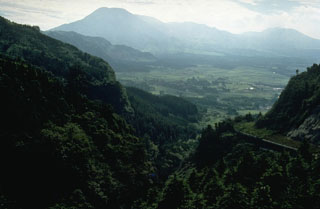Report on Asosan (Japan) — 26 November-2 December 2014
Smithsonian Institution / US Geological Survey
Weekly Volcanic Activity Report, 26 November-2 December 2014
Managing Editor: Sally Sennert.
Please cite this report as:
Global Volcanism Program, 2014. Report on Asosan (Japan) (Sennert, S, ed.). Weekly Volcanic Activity Report, 26 November-2 December 2014. Smithsonian Institution and US Geological Survey.
Asosan
Japan
32.8849°N, 131.085°E; summit elev. 1592 m
All times are local (unless otherwise noted)
JMA reported that on 25 November an eruption from Asosan’s Nakadake Crater occurred after increased tremor detected a few hours earlier. Ash plumes rose from the crater and produced ashfall to the E in Hanoi Aso (Kumamoto Region), Taketa (30 km NE, Oita Region), Gokase (25 km WSW, Miyazaki Region), and in Minamiaso (10 km SW, Kumamoto Region). Incandescence from the crater was recorded at night with webcams. On 26 November tephra was ejected 100 m above the crater rim and an ash plume rose 1 km. Tremor continued to be elevated. The eruption remained strong on 27 November, and ash plumes rose 1.5 km. During a field survey in an area S of Nakadake Crater volcanologists observed Strombolian activity in the crater, 7 cm of ash deposition, and fist-sized scoria. Ashfall was reported in a wide area to the W, mainly in Kumamoto (38 km WSW). According to a news article, flights in and out of Kumamoto airport were either cancelled or diverted. On 28 November ash plumes rose 1.5 km. The eruption continued through 30 November; ash plumes rose at most 1.5 km and incandescent material was ejected onto the crater rim. Inclement weather mostly prevented views of the crater during 1-2 December, but the small-scale eruption likely continued. The Alert Level remained at 2 (on a scale of 1-5).
Geological Summary. The 24-km-wide Asosan caldera was formed during four major explosive eruptions from 300,000 to 90,000 years ago. These produced voluminous pyroclastic flows that covered much of Kyushu. The last of these, the Aso-4 eruption, produced more than 600 km3 of airfall tephra and pyroclastic-flow deposits. A group of 17 central cones was constructed in the middle of the caldera, one of which, Nakadake, is one of Japan's most active volcanoes. It was the location of Japan's first documented historical eruption in 553 CE. The Nakadake complex has remained active throughout the Holocene. Several other cones have been active during the Holocene, including the Kometsuka scoria cone as recently as about 210 CE. Historical eruptions have largely consisted of basaltic to basaltic andesite ash emission with periodic strombolian and phreatomagmatic activity. The summit crater of Nakadake is accessible by toll road and cable car, and is one of Kyushu's most popular tourist destinations.
Sources: Japan Meteorological Agency (JMA), Agence France-Presse (AFP)

